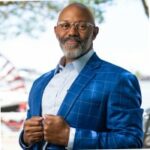
You are the ultimate innovator of your life, and as a person, you are bound to seek a better way to do everything. So how can you make things better? The strength of your WHY is the same thing that presents as a challenge. Nothing is ever “right” because things can always be “better.” Raymond Kemp is an experienced senior executive in leadership and Human Resources. He joins Dr. Gary Sanchez in this episode to talk about WHY we tend to find and pursue a better way of life. Listen in as they discuss the WHYs of improvement and the endpoint of contentment.
—
Watch the episode here:
Listen to the podcast here:
The Strength Of Your WHYs: Finding A Better Way To Success With Raymond Kemp
In this episode, we are going to be talking about the why of a better way. If this is your why then you are the ultimate innovator and you are constantly seeking better ways to do everything. You find yourself wanting to improve virtually anything by finding a way to make it better. You also desire to share your improvement with the world. You constantly ask yourself questions like, “What if we tried this differently? What if we did this another way? How can we make this better?” You contribute to the world with better processes and systems while operating under the motto, “I’m often pleased but never satisfied.”
You are excellent at associating, which means you are adept at taking ideas or systems from one industry or discipline and applying them to another, always with the ultimate goal of improving something. I have a great guest for you. His name is Raymond Kemp. He is a highly experienced Senior Executive in leadership and Human Resources. He has years of experience at the highest levels of the US Navy as the Fleet Master Chief of Europe and Africa. In his duty assignment, Raymond directed and influenced over 56,000 service members, civilians, contractors and family members across the European and African continents.
He revolutionized Naval leadership education by creating the seminal document, “Laying the Keel,” with an emphasis on character and professional competency. More than 30,000 senior enlisted trainees were impacted by this document. Widely recognized for his exceptional leadership skills, Fleet Master Chief Kemp has received honors from the Office of the President of the United States and the Department of the Navy. Joe Biden appointed him to the American Battle Monuments Commission. Chief Kemp, welcome to the show.
Thank you very much. It is a pleasure and honor to be here with you.
This is going to be a lot of fun. I have been looking forward to having you on the show for a while. I am glad we finally get to do this.
I have had the opportunity to be connected to the WHY Institute and it has been an honor. I have been watching. I was like, “I wonder if I’m going to ever get on to the show?” Here we are and I’m excited about it.
How tall are you?
[bctt tweet=”Leadership is the willingness to step out and be the example; to walk that mission, vision, and guiding principles in a way where others are willing and able to follow. ” username=”whyinstitute”]
I go about 6’1”, probably 230 pounds of twisted steel and sex appeal. I have my fair share of time in the weight room and on the track.
Where were you born? Where did you grow up? What were you like in high school?
I was born in the great nation of Texas and raised in Oklahoma. In high school, I ran track and played football. I was thin growing up. If the wind blew hard, I could feel it. I was lightning fast. I have been a quarterback on a football team in Oklahoma which that is absolutely a sanctuary of both Oklahoma and Texas. Things worked out in my favor. I was shy and finding my way. Maybe because I was thin and I had a bit of a speech impediment, I had a lot of ideas but not necessarily a voice. As I made my way into the Navy, I joined the Navy 30 days after I graduated high school so things accelerated pretty quickly.
Why the Navy?
I was born in the ’60s raised in the ’70s. I vividly remember 60 minutes talking about stress and hypertension in those days. I have seven aunts. They would get up in the morning and they would be going off to work but I had an uncle who would be at home. I would go over to this little town called El Reno in the summertime. They would all go off to work and I thought to myself, “I don’t want that stress.” My uncle stayed there with my cousins and me. He would say, “Go out there, pick up the twigs underneath that tree and bring in some baby carrots.” I thought, “That is the job I want.”
I didn’t realize that he was a Marine. He served in World War II, Korea, Vietnam and retired from the services. Once I realized that that was his way to make ends meet and he had retired, I was like, “I want to do that.” When the recruiters came to the school, I took the Armed Services Vocational Aptitude Battery Test. I did pretty well on it. The Navy had a great offer and promises to see the world. They had some Gucci uniforms. It was an easy decision for me.
It seemed like a better way.
I was pretty decent at football and good at track. I had a couple of offers to do some things in school but I was tired of school. It wasn’t that I wasn’t good at it. I didn’t like it anymore. There was a different opportunity or a better way and there I went.
What was it like going into the Navy at that age and time?
I want to be very clear about this. When I was making my way through, it was what it was. It was the mid-’80s. You think about leadership in the Navy at the mid-level and higher-level is once you get into the 15, 20-year mark. I joined the Navy in 1986. The leaders there had joined the Navy in 1966 or the late-’60s and early-’70s. That means that they were living through the civil rights era and a very grotesque social climate in America at the time for somebody who is Black like me. When I joined the Navy, it was what it was. I was born in Texas and raised in Oklahoma.
I had been called all sorts of names and treated in various different ways but I learned how to survive. When I joined the Navy, I became a Data Processing Technician. I went to my first ship which is an aircraft carrier out of Philadelphia, Pennsylvania. My first interaction with a master chief, the 1% of the Navy, was to check into the ship. I had never seen one in person. I’m expecting to go into the Automated Data Processing Center which is where all the computer dudes went. He told me, “I don’t allow any people in a computer room so you are going to go over here and do this manual labor.”
That language to some people might be shocking but to me, it was just language. My aunts, mother and grandmother were fierce angels. They told me of this rhyme, “Sticks and stones may break my bones but words will never hurt me.” That language he used meant nothing to me. I had been told that the Navy and Military was a meritocracy. I was like, “Where do I go?” Once I found out where I went, I went in and did my best regardless of whether it was what I was trained to do as a Computer Technician or not. Ultimately, it ended up working out. I made my way into the Automated Data Processing Center and just crush grooving and body moving after that.

How long did it take you to get to what you went there to do in the first place?
In those days, it was common to do some temporarily assigned duties. KP duty was what it was called in the old days. For me, it took nine months. It was supposed to be a three-month event but for me, it ended up being a nine-month event. During that nine months, what he meant for my bad, worked out for my good because my goal was to go in, make E-5, retire and go back to Oklahoma. He had sent all of the other Blacks into that particular division. As soon as I got there, I was like, “There is an E-5 right there.” If he can do it, I know I can do it. He will probably help me if I ask a question and he showed me the way. That was exactly what happened. By the time that nine months was over, I was already fully prepared to make the first advancement in my career and I did. I’m ahead of my peers and they say, “I was on my way.”
You went from doing KP duty to doing data processing. How long were you there?
I was in the data processing field and information systems technology field for twenty years. I transitioned into the command path of the Navy. I was there for four years, from ‘86 to ‘90. I did some time in the first Gulf War which started around 1991. I was stationed in Washington, DC at the time. I was hopping around the globe. My first tour of duty was the bootcamp in San Diego but then from Philly back to San Diego to Washington, DC. I’ll be in California. I moved around a lot.
Twenty years in the IT field and then you set into leadership.
The Navy path is you are either in your technical field or at a certain rank. You can transition to a strict leadership field. At the 24-year mark, I transitioned from the Information Systems Technician Master Chief, which was the actual work was the top of the field at the time. I was stationed in Pentagon and then I transitioned to be a Command Master Chief. I had the opportunity to be selected to go to the Army Sergeants Major Academy, which is a full school year out in El Paso at Fort Bliss. I went to my first ship as the Command Master Chief. The Command Master Chief, Commanding Officer and Executive Officer are the triads of command. The three who are in charge of the fighting, training and administration of the ship.
[bctt tweet=”People really don’t care how much you know until they know how much you care.” username=”whyinstitute”]
Is it common for someone to go from KP to a Master Chief?
The KP would be the very beginning of the career. That nine months’ worth of training and hard labor because I was painting walls, pulling tile up off of the deck on the ship, re-putting a tile down and replacing desks and racks and things like that. Lots of miscellaneous and heavy labor stuff. That was the beginning of my career.
Once I transitioned into the computer room after those nine months, I was able to stay there and then maneuver within the information systems technician responsibilities to the highest levels. At that point, I made that transition. It’s not common because according to the US Code Title 10, the law, only 1% of the Navy can be master chief. It’s uncommon to make it to master chief. Once we get there, it’s about 330,000 people in the Navy. In that top 1%, there were only 600 that were command master chiefs.
Why didn’t you quit? When you weren’t given what you wanted when you were told to do something you didn’t want to do and you were told in a way that wasn’t nice, why not quit?
I’m from a group of people who taught me the value of hard work and let me know that I’m always representing somebody other than myself. Quitting was not an option. There was not necessarily a point in my career where I was thinking about other people. I was often thinking about a better way for me to get into a position to have some impact and influence over this organization. From a division, departmental level, onboard the ship, to the entirety of the ship and perhaps even a fighting force, I sought after that. I knew that I wanted to have an influence but when I got to the twenty-year point, the time that I could retire. I was 37 years old. I could get a good pension and go back home but I still have things to do. I realized that I could go higher.
What was the transition like going from IT to leadership?
The pathway in the Navy had given me exposure to more than IT. When I was on an aircraft carrier, we had approximately 5,000 or so people. Amongst that 5,000, maybe only 100 to 200 worked in combat systems. As a duty section leader, when the ship pulls into the port whether it be overseas or at home in America, there has to be a small contingent that stays onboard the ship in case there is an emergency like fighting fires or getting the ship underway. In the event of something as catastrophic as 9/11, be able to put the ship out to sea and then fight the ship at sea. As a duty section leader, I have exposure to all different ratings and professional responsibilities onboard the ship.

I enjoyed having the impact and influence on other professions than just information systems. I knew I wanted to go to a higher level. The day that I got advanced to master chief, my Command Master Chief said, “I want your package on my desk on Monday. No excuses.” He too, wanted me to go into that rating. Once I made that transition and had the opportunity to use my intellectual agility to help people solve their problems at a higher level, it was extremely challenging. It was very satisfying because my perspective, background and job were different from other jobs.
For example, an Aviation Ordnanceman is someone who builds bombs, loads them on aircraft, we launch those bombs and deal with data. The information system technician has a different processing level of troubleshooting problems and things like that. When I had the opportunity to share this different perspective with these other jobs, it was fulfilling to see them grab ahold of those ideas and realize there is a better way.
How long were you in leadership and a Master Chief?
I was a Master Chief for eleven years and I was in that leadership position for that same amount of time.
What is it like leading in the Military versus now you are out of the Military and leading in the civilian world?
It’s not very much of a difference. The difference is that there as different risks. Life and death is a real thing in a combat environment and onboard ships. There is a greater measure of obligation given to an enlisted person. There is a higher level of loyalty built into, “I will stay here without question for at least four years until I transfer to another command or until I met my obligation and I get out of the Navy.” In the civilian world, we know there is not that same measure of loyalty to an organization without some leadership built into it.
It is interesting that we are having this conversation because I was playing some golf with a friend of mine who is a colonel here at the Air Force base and is about to get out. I did some work with the Air Force. I found it interesting how he was able to talk to the people he was in charge of. The word choices were not necessarily what I would expect in the private world or civilian world versus what he was able to say. You could order someone to do something as the leader, whereas in the civilian world it’s a different conversation, at least that was my perspective. How do you feel about that?
[bctt tweet=”When you’re able to express a measure of care, you create a measure of trust. ” username=”whyinstitute”]
There is a difference in the way we communicate in the Military than in the civilian sector. That goes to a couple of things. First and foremost, there is an expectation of a measure of aggression, honor, courage, commitment and dedication to the mission you are assigned to and the organization. Whereas in the civilian sector, there may not be that same measure of obligation. There may not be that, “I’m all in or I’ll die for you,” in there. Because there is a disparity like that then there is a lot more influence that has to go into the leadership rather than by order. The hardest and biggest challenge for myself and those like myself who had turned a certain rank, even with that colonel is learning the language.
Also, learning that I have a certain level of care that I will be able to express to you through language but also in the way that I treat you with dignity and respect will generate some momentum. What I have found, at least as I have talked to others who have decided to go and work in the civilian sector, what they have done is they have realized that, “My language has to be different but my heart does it. I can still lead with my heart. I can still let somebody know that I’m all in for them. I shift my language.” That same measure of influence is in place and then they can still lead the way.
I asked him this question after I went out to work with him because it was so odd for me. I haven’t been in the Military. We went and had lunch and he walked into the room and everybody stood up. He walks to the front of the line and gets his food. I’m right there with him and it’s an odd experience if you’re not used to that. I said, “You’re in here, you’re the guy and you go outside of the base and nobody knows and you don’t get that same treatment. What is that like for you mentally to be the guy in there but nobody else knows that?”
Each service does it differently. Some folks believe that leaders should eat last and all their troops should eat their food first. They should ensure that they are taken care of. When they come in and are troops, sailors, airmen soldiers and Marines, they see that they allow them to eat first. If they are eating last, that generates a certain measure of sanctity within the organization. For the Navy and the senior officers in the Air Force, what ends up happening is that they are continuously reminded that you are just a man. There is a trusted agent that they have that is close to them that reminds them that they are not a God. As the Stoics would say, “You are just a man.”
When that transition takes place then we are able to make that transition realizing and knowing that only in certain environments will folks stand or make a hole so you can get by. Interestingly, my aunts came to visit. I’m twenty or so years into the Navy. They are going to see Oprah Winfrey. She had a play on Broadway. My ship happened to be in town. They are like, “We should go by and see Raymond.” They come to the ship. We have about 10,000 visitors per day. The line is a mile long. I tell them, “Tell the taxi cab to come to the street.” They come to the very front. They have been with me my whole life.
We took some photos but it was their first time to see me in uniform and my workspace. The line is probably a quarter-mile. Maybe about a par five from where we were standing to get to the pier. I put my hand on the sailor’s shoulder and I was like, “Do you mind if we get by?” He looked over his shoulder, he saw me and he was like, “No problem. Hold on, would you take a picture with my mom?” I click. We take a photo and then he shouts, “Make a hole.” Hundreds of people moved out of the way. My aunts are looking at each other like, “What in the world is going on?” They slip into character. They didn’t slow down at all. They stepped right in between everybody and made their way up to the front.
I share that long story with you that we realized that it’s only in those environments where that takes place, not at the grocery store, if we go to Ruth’s Chris or anything like that but only in that environment. That transition in the workplace is a bit tough because you expect people to bow down to that measure of service you have got before, especially in a meritocracy. That transition into the workplace and those folks not maneuvering that way is somewhat of a challenge for Military members.

Let’s talk about Laying the Keel.
Thinking back to the days when we were building wooden ships and that one hard piece of wood that went down the middle was the keel. We build out from there. What we had done in the Navy is we had gotten away from leadership fundamentals in a step-by-step way to growing and building. In laying the keel, there are several different portions of the document and I wasn’t responsible for the entirety of the document. I was responsible for the initiation of the senior enlisted portion of the document. We methodically built out leadership waypoints for sailors as they make their way through their careers.Whether it be Sailor 360, a very specific educational program that they went offsite to learn to a means of when you get back to your command and continuing that conversation. The Laying the Keel document itself was the formality of building out a sailor individually throughout their career. There are different waypoints so that they would be soundly built to make their way to those senior positions.
It sounds like it’s something that would be good for businesses as well.
There is no doubt. These days, it’s important for there to be some measure of hierarchy, though we seem to be seeking after very flat organizations. It sounds seductive to have a flat organization where everybody seems to be equal but there has got to be some structure there. Whether you have a very young person who comes in like NASA who has got innovative, great ideas that are rocket science, I’m sure that is absolutely important.
It’s smart to train folks in such a way where one, they know how to talk to people. Two, they know how to put those structures in place so that they can, in a very balanced way, award and celebrate those things that are done properly. I agree in the civilian sector, it would be very useful to ensure that people, as they make their way towards the C-suite or executive suite, they have the proper training to maneuver in that space once they get there.
Do you do leadership training?
[bctt tweet=”Your attitude determines your altitude.” username=”whyinstitute”]
I do some training and coaching but the majority of what I do is come in and talk to them about leadership. Every now and then that leads to, “Exactly what do you mean by the ABCs of leadership?” I can then talk to them about attitude, belief, character and how to grow those leaders in a fashion that you want them to leave the company.
How do you define leadership?
Leadership is the willingness to step out and be the example, to walk that mission, vision and guiding principles in such a way where others are willing and able to follow you.
Is leadership something you can learn? Is leadership something you either have or don’t? What have you seen?
In my experience, it’s much the same as my daughter, Mahogany is an uncanny skill at throwing a football. She has a flat-out canon and it’s not something that I taught her. She got some decent DNA. She can throw a very tight spiral at a great distance. Leadership, in the same way, there are some people who have the ability to communicate with others in such a way that it inspires confidence. There are some folks, like myself, who may not have started with a high level of confidence but grew and developed it based on experience and then became a leader. Oftentimes, there is an argument between do you build leaders or are born? I would say both. There are some who are born into it and they can become better. There are some who may not necessarily be born into it but we can develop those leadership traits to help them get there.
What was the biggest turning point in your life or career where you said, “Now, I’m a leader,” because you said you were shy? You didn’t feel like you had a great speech. You went into the Military and at some point, you had to become a leader. What was that turning point for you?
It happened early. What I didn’t mention is that growing up in elementary school and high school, I played sports and oftentimes because of my athletic prowess, I was somewhat of a leader. I wasn’t always a team captain but once I joined the Navy, I was four days in and they told me, “You are the sixth squad leader.” They told me in bootcamp that Navy means Never Getting Volunteered Yourself. I was responsible for twenty other folks within my bootcamp company. It was at that point that I realized that even though I may have this slur, lisp or whatever name that other people might give it. I’ve got to get over that. I’ve got to help people on my team understand how to do push-ups and things like that.

It was at that point when the leadership was thrust upon me that I realized, “This is what my life is going to be. I’m going to lead the way the whole way.” That was exactly what happened. At different levels throughout my career, there was a time when I was assigned to do something that I didn’t fully know. Whether it be a technical thing or a warfighting event, I didn’t fully understand how to do it specifically but I understood how to tap into the people who did, build a resilient team and then fight one.
How do you do that? How do you tap into the people you have and build a resilient team?
The first thing that has to happen is to express a level of care. It has become common to say that people don’t care how much you know until they know how much you care. When you are able to express that measure of care, that creates a measure of trust because trust is super important. The next thing would be the attitude. I come from an environment where they say that your attitude determines your altitude. With a good attitude and a positive outlook, you create an environment where the folks in your stead realize that when you care about them too, you have a solid attitude. It’s not just a good attitude despite it all. It’s because you have studied and prepared.
The next is belief and character. First of all, belief comes when you have studied, surveyed the territory and helped people understand that what we are doing is a righteous event and stuff that needs to be done. Doing those things with a character that is when no one else is looking, people know that you are giving it your all and that there is honor and integrity in what you are doing. That creates an environment where those folks working with you, no matter what their background or differences, there may be between you that you are trustworthy and people will follow after that.
That is the ABCs, Attitude, Belief and Character. It’s almost like the ABC.
That level of care is the first step in building trust.
You mentioned that because of your stature and size, you could be easily misinterpreted. How have you overcome that?
If I had known the language of my why, how and what, that would certainly have helped. In the last years of my career, I carried probably between 250, 260 pounds. I was hulking in my presence. I used to tell people that this is all leadership. If I would come into this base, I have my hand on the thermostat just on my physical presence. Because of that, it made some people uncomfortable. If I had the language of, “I am truly here to find a better way. The way that I’m going to do that is by challenging the status quo and traditional thinking, which may be a bit intrusive. I assure you that what you are going to feel when I leave is that there has been a contribution made to everyone who works here and to the greater good of the mission of this particular organization.”
[bctt tweet=”There are some people who have the ability to communicate with others in a way that inspires confidence. And there are some who may not have started with a high level of confidence but grew and developed it based on experience.” username=”whyinstitute”]
I didn’t have that at the time so I had to prove it. I would enter into a space. I would go in and talk to people, especially as the Inspector General for sailor programs for the Navy. It was often intimidating. I would come into a space and look to establish that level of care and the sincerity that would allow me to prevent misinterpretation or unexpected coercion.
How long have you been out?
I retired in 2019.
How has that been for you?
It’s been interesting. It was a little clunky. I spent about a year in Virginia and then COVID came. I wasn’t sure exactly what I wanted to do whether I wanted to go work for another organization or start Kemp Solutions and do that full-time, which I chose to do. It has been exciting, rewarding and fulfilling because, first of all, to be an entrepreneur is super-duper challenging but then connecting with good people and finding out information helped me become a better person. When I connected with Dan, Lisa Schermerhorn and got introduced to yourself and the WHY Institute. My life accelerated in a way that I can see inside myself and I’m thinking, “I can’t wait to share this with others.” It has been an exciting time.
With Kemp Solutions, who would be your ideal client? Who are you looking to work with?
Not necessarily trapped into a particular industry but a diverse organization that is looking to build their resiliency and loyalty within their organization are the exact right folks for me. I can talk with them as a leadership expert and help them maneuver between the challenges we have been making our way through. Whether it is the social injustice and reform we are fighting through in society or the pandemic. Those organizations that are looking to build strong teams in that environment are the right ones for me.
I’m going to give you a challenge. This is a common scenario that I hear and probably people reading this could be experiencing this same thing. We are taught in a lot of the leadership courses and experts about five generations of people in the workforce. They all came from different backgrounds and experiences. You have more women, minorities and diversity. Everything is diverse but with that comes a lot more unknowns. How do you handle working with a 50-year-old versus a 40-year-old versus a 30-year-old versus a 20-year-old? Sometimes we are taught, “You have to know everything about each one of them to be able to handle their different issues.”
It almost feels like you are babying them. You got to baby your team to get them to do anything and it doesn’t seem like it works very well. I was met in the parking lot by a guy that said, “I got to talk to you. I tried that route. I watched it happen.” It has backfired a little bit on him. He is almost feeling like he wants to go the opposite route where it’s like, “I don’t want any babies on my team. I don’t want to have to deal with all your crap. I don’t want to know all the stuff going on in your life. I want you to come and do what we need to have done.” What is your perspective on that?
I am not a big fan of handholding and spoon-feeding. However, I realize that there is a time to hold hands and bring that spoon to someone else’s lips. When an organization has a standard that everyone is clear on, “They are the bedrock foundations of our company, this and this. We shall do our level best at all of these things and that is who we are.” I am not necessarily seeking to over diversify, force or ensure that we have this smattering of people throughout the organization. What we do have is a standard that the organization is going to work towards as a whole.Especially at the head, when you’re doing things in goodness , in order and character, they will trust to know that no matter what the face of your organization is, they will know that the standard is maintained. Knowing every single thing about a person depending on the size of the organization is certainly challenging. Expressing a level of care beyond just the cursory, “How was the weekend? How are the kids?” Knowing the kids’ names and things like that. When you are operating with sincerity, people realize that it is true. That is when that trust goes beyond the formality of the organization.
It’s not necessarily an overabundance of babysitting, handholding and spoon-feeding. It is a true expression of the company’s mission, vision, guiding principles and the standard at which we are going to work within the organization. That is what is going to draw people in and it’s going to draw and build that loyalty as well. I’m somewhat disappointed when some leadership experts say the same thing you are talking about. You have to know every person’s intimate details and be drawn into those things. We need to let people know what our standards are, adhere to those standards, do our best and then keep it pushing.
The part about setting the standard, living the standard and being the standard, this is the way we do things is so valuable because that oversees or overshadows everything else. If you meet the standard and you want to be part of this standard, you are in. If you don’t want to be part of this standard, that is okay too.
There is another opportunity for employment in other places.
What I noticed with the one that I was talking about is they have some high standards but I’m not sure the leader lives the standards visibly.
That is the thing too. The culture comes from the highest level of leadership. The climate comes from that frontline supervisor. The highest levels in leadership need to ensure that those frontline leaders understand and know that they are not talking about it but they are walking and talking about it. Those frontline leaders are the ones who can convey to the rest of the workforce, “I know for sure that the leadership is doing these things even though you may not see them,” because what happens is you build some synergy in the relationships. If the leader at the highest levels of leadership is not doing it then the culture is going to be a little shaky.

If people are reading that want to have you speak, work with their teams and companies or mentor them, what would be the best way for them to get in touch with you?
My website is www.Kemp-Solutions.com. I’m on all social media platforms @RaymondDKemp. On LinkedIn is Raymond D. Kemp Sr. I’m available.
Thank you so much for being here. I’m sorry to put you on the spot like that.
I like it.
I figured you probably would. That was a better way that you came up with. Thank you so much for spending the time with us. I look forward to working and staying in touch with you as we go on our journeys. What is the best piece of advice you have ever been given or gotten?
The best advice that was ever given and I continue to give to others come in the form of ten two-letter words that make you a better man, woman and leader. Those words are, “If it is to be, it is up to me.” It is a bit of a mantra that I live by. I’m not looking for a handout. I’m looking to make my own way. I’m looking to help other people do the same. I was told that some number of years ago as I was fighting my way through some challenges in advancement in the Navy. It had worked out in my favor. Everyone could use those ten two-letter words.
We have all heard it but living it is something different. How were you able to live that?
The Navy determines your professional capabilities in your written exam and the school system that I went through didn’t necessarily prepare me for multiple-choice tests, certainly not worded in the way that I was given. I realized that the rote memory techniques that I had been taught weren’t necessarily the best ones for me. I had to shift into using flashcards and other diverse means of preparation. When I realized there is not just one way to do things, there are many different ways. I realized, “I’ve got to make sure I do my due diligence and do my best when it comes down to everything I put my hands to if I want to be successful.” That was it. Despite what anyone else said or the obstacles in front of me, it was about effort. It was persistence over resistance.
I have another question I wasn’t probably supposed to ask but it popped in my head and I want to ask you. You didn’t have it easy. You weren’t given everything that you got. You had challenges to overcome. You had people that didn’t treat you nicely. You had a lot of stuff that maybe wasn’t right. How did that shape you? Did it shape you? It didn’t destroy you. In this world, everybody is offended by everything. You try to take every offensive thing out of life to have a perfect upbringing. I wonder if that will end up being a good thing.
I did not grow up in an environment where everybody got a T-shirt and trophy. I grew up in an environment where you had to earn what you got. Even when it was systematically unfair that there were still some good things that came out of that. The master chief I talked to you about when I first joined the Navy was throwing dirt on top of me. He had no idea I was a seed. I would grow into the tree that I became and bear fruit. I’ll never taste some of that fruit but still bear fruit so that other harvests could grow. I do believe that there is something wrong when we try to avoid offending or create some environment where people don’t have to come against controversy and friction.
I believe that the friction that I went through was what I needed to grow and be built into who I became. It’s the same as I believe that it is okay for there to be some measure of friction and disagreeance. There is great value when we can come together and reason with one another. There shouldn’t just be abuse as we have seen throughout American history and beyond. It didn’t destroy me. When I looked back over the challenges that I overcame, they created me into who I am.
Thank you.
—
It’s time for our Guess The Why segment and for this segment, I want to use somebody that a lot of people know, especially if you’re into sports and you followed Tom Brady and the New England Patriots. I want to know. What do you think is the why of Coach Bill Belichick? He is always in the hoodie. He is known as the guru in football. He has won the most championships of anybody. He did have Tom Brady on his team. There is the debate of is it because of Tom or Bill? He is known as a great mind in the football world.
What do you think his why is? I think his why is to make sense. He is able to make sense out of complex and challenging things and help people get unstuck, move forward, be able to zig and zag and make adjustments on the fly easily. That was what made him into a great coach. What do you think? If there is an area for comments, let us know what you think. Thank you for reading. If you have not yet discovered your why, you can do so at WHYInstitute.com. You can use the code PODCAST 50 and get it for half off. If you love the show, please don’t forget to subscribe below. Leave us a review and rating on whatever platform you are using. Thank you so much for reading.
Important Links:
- Kemp Solutions
- @RaymondDKemp – Instagram
- Raymond D. Kemp Sr – LinkedIn
- Raymond@Kemp-solutions.com
- Raymond@KempLeadership.com
About Raymond Kemp
 Raymond Kemp is a highly experienced senior executive in leadership and Human Resources. He has over 10 years of experience at the highest levels of the US Navy. As the fleet master chief of Europe and Africa, In his final duty assignment Raymond directed and influenced over 56,000 service members, civilians, contractors and family members across the European and African continents.
Raymond Kemp is a highly experienced senior executive in leadership and Human Resources. He has over 10 years of experience at the highest levels of the US Navy. As the fleet master chief of Europe and Africa, In his final duty assignment Raymond directed and influenced over 56,000 service members, civilians, contractors and family members across the European and African continents.
He revolutionized naval leadership education by creating the seminal document “Laying the Keel” with an emphasis on character and professional competency. More than 30,000 senior enlisted trainees were impacted by this document.
Widely recognized for his exceptional leadership skills, fleet master Chief Kemp has received honors from the office of the president of the United States and the department of the Navy. He was most recently appointed by Joe Biden to the American Battle Monuments Commission.

